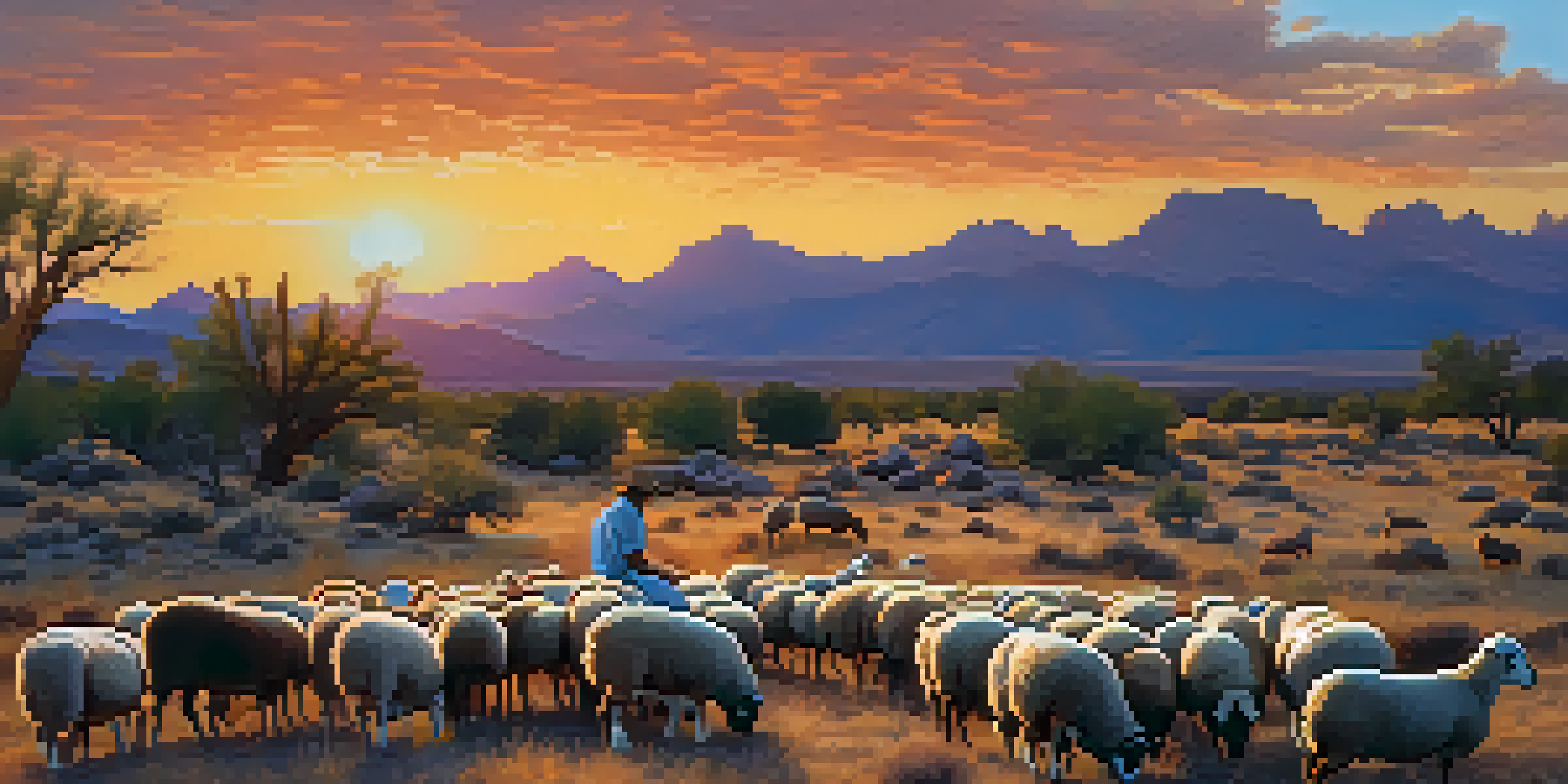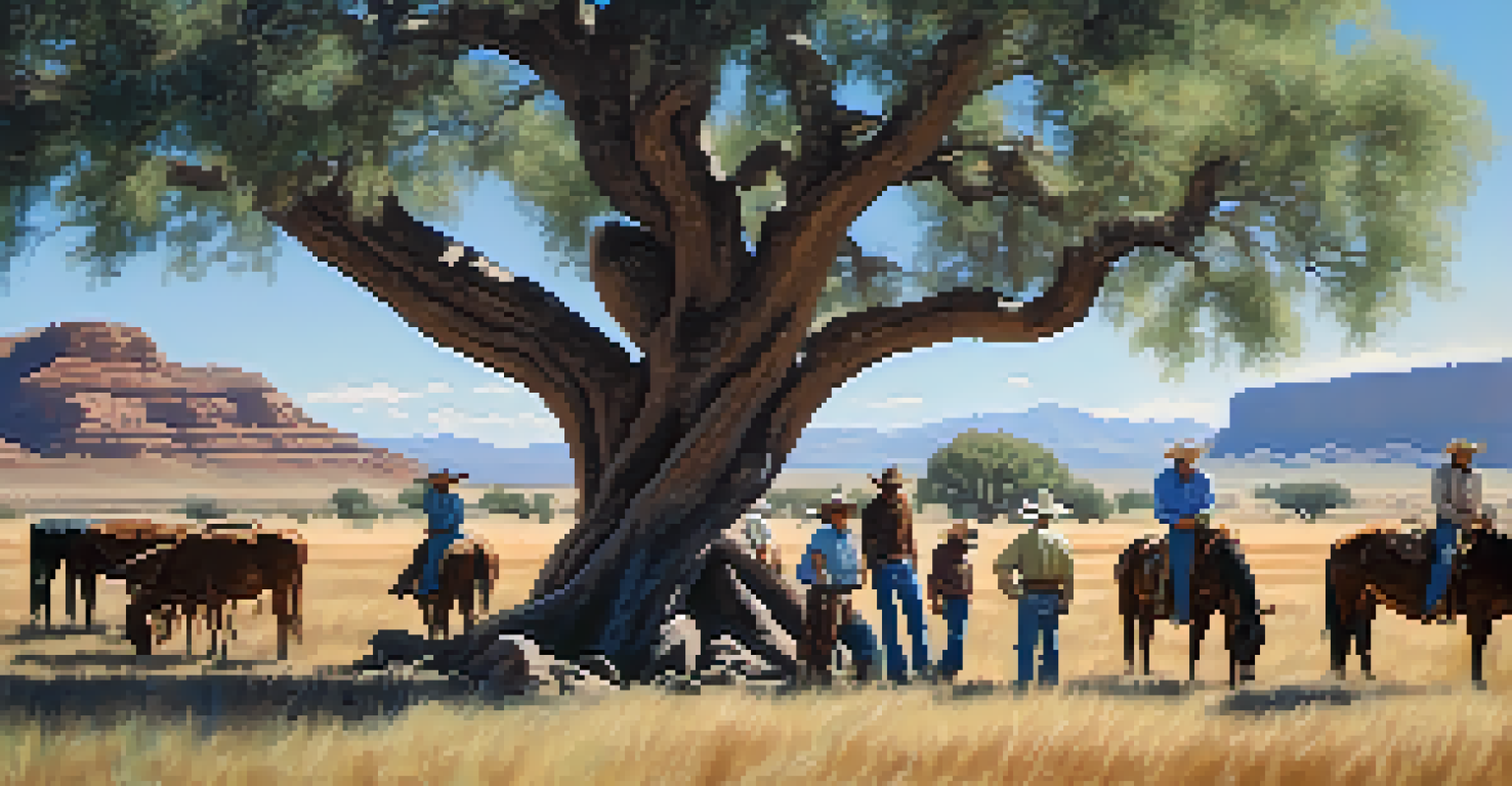The Influence of Native American Culture on Arizona Ranching

The Rich History of Native American Ranching in Arizona
Native American ranching in Arizona has roots that stretch back centuries, intertwining with the land's rich history. Indigenous tribes, such as the Navajo and Apache, have long practiced sustainable land management, which has significantly influenced modern ranching techniques. By observing the natural ecosystem, they learned how to raise livestock while preserving the environment, a lesson that remains relevant today.
The land is the source of life, and we must return to our roots to understand how to live in harmony with it.
These early ranchers utilized a variety of livestock, including sheep and cattle, adapting their practices to the harsh desert climate. For example, the Navajo Nation is renowned for its sheep herding, which not only provided food and wool but also played a crucial role in their cultural identity. This blend of practicality and culture laid the groundwork for ranching in the region.
As settlers arrived, they often adopted these methods, blending Native American knowledge with their own practices. This historical fusion has created a unique ranching culture in Arizona, highlighting the importance of respecting and learning from indigenous practices.
Sustainable Practices Rooted in Indigenous Wisdom
Sustainability is a key theme in Native American ranching practices, emphasizing harmony with nature. Indigenous tribes traditionally used rotational grazing techniques, allowing land to recover and thrive, which ranchers today are increasingly recognizing as essential. This method not only benefits the environment but also enhances the health of livestock, creating a win-win situation.

Moreover, the use of native plants for forage rather than introducing non-native species is another sustainable practice that has its origins in Native American culture. These plants are better adapted to the arid climate of Arizona and contribute to healthier ecosystems. By prioritizing native flora, ranchers can improve soil quality and reduce water usage, addressing some of the modern ranching challenges.
Indigenous Wisdom Enhances Ranching
Native American ranching practices emphasize sustainability and community, blending traditional techniques with modern methods for better environmental stewardship.
Incorporating these indigenous methods into contemporary ranching not only promotes environmental stewardship but also honors the deep-rooted traditions of Native American communities. It serves as a reminder of the wisdom that can be gained from those who have lived in harmony with the land for generations.
Cultural Significance of Livestock in Native American Traditions
Livestock holds deep cultural significance in Native American traditions, symbolizing wealth, community, and spirituality. For many tribes, animals like sheep and horses are not just sources of sustenance but also integral parts of cultural ceremonies and storytelling. This connection to livestock enriches the ranching experience, making it more than just a business venture.
We do not inherit the earth from our ancestors; we borrow it from our children.
The significance of livestock is evident in the way Native Americans celebrate their herding traditions through various events, such as rodeos and festivals. These gatherings foster community spirit and allow for the sharing of knowledge and skills passed down through generations. Ranchers today can learn valuable lessons from these traditions, emphasizing the importance of community in ranching.
Recognizing the cultural importance of livestock can also lead to more ethical ranching practices. By viewing animals as part of a larger community rather than mere commodities, ranchers are encouraged to prioritize animal welfare and sustainable practices.
The Role of Native American Art in Ranching Culture
Native American art plays a significant role in expressing the rich heritage of ranching culture in Arizona. From intricate beadwork to stunning pottery, these art forms often depict ranching life, showcasing the beauty and struggles of living off the land. This cultural expression not only preserves history but also inspires modern ranchers to connect with their roots.
Many contemporary ranchers incorporate Native American art into their ranching lifestyle, using it as a way to honor the land and its original stewards. For instance, ranchers might display Native-inspired artwork in their homes or use traditional designs in ranch branding. This fusion of art and ranching creates a unique identity that reflects a deep respect for both cultures.
Cultural Significance of Livestock
Livestock is deeply rooted in Native American culture, symbolizing wealth and community, which influences ethical ranching practices today.
Additionally, art serves as a medium for storytelling, passing down ranching traditions and values to future generations. By sharing these stories through art, ranchers can foster a sense of pride and connection to their heritage, ensuring that the influence of Native American culture continues to thrive.
Collaboration Between Ranchers and Native American Tribes
In recent years, there has been a growing trend of collaboration between ranchers and Native American tribes in Arizona. These partnerships aim to blend modern ranching techniques with indigenous knowledge, fostering a more sustainable and respectful approach to land use. By working together, ranchers and tribes can address common challenges, such as drought and land degradation.
Such collaborations often involve sharing resources and knowledge, leading to innovative solutions that benefit both parties. For instance, ranchers may learn from the tribes' water conservation techniques, while tribes may benefit from improved livestock management practices. This exchange of ideas not only enhances ranching practices but also strengthens community ties.
These partnerships also serve as a platform for cultural exchange, allowing ranchers to gain a deeper appreciation for Native American traditions. This understanding fosters respect and creates opportunities for celebrating the rich cultural tapestry that shapes Arizona's ranching landscape.
Challenges Facing Indigenous Ranching Today
Despite the rich heritage and sustainable practices of Native American ranching, modern challenges pose significant threats. Climate change, land disputes, and economic pressures are just a few factors that impact the ability of indigenous ranchers to continue their traditions. These challenges can lead to a decline in livestock populations and the erosion of cultural practices.
Additionally, many Native American ranchers struggle with access to resources and funding necessary for sustainable ranching. Limited financial support can hinder their ability to implement modern practices or preserve traditional methods. This economic disparity underscores the importance of advocacy and support for indigenous communities.
Collaborative Efforts for Sustainability
Growing partnerships between ranchers and Native American tribes aim to combine indigenous knowledge with modern ranching to tackle challenges like climate change.
Addressing these challenges requires a collective effort from both ranchers and the broader community. By recognizing the value of Native American ranching and supporting initiatives aimed at preserving these practices, we can ensure the survival of this vital part of Arizona's cultural heritage.
The Future of Ranching: Embracing Native American Influence
As we look to the future, embracing the influence of Native American culture in ranching offers a path toward sustainability and resilience. The lessons learned from indigenous practices can guide ranchers in navigating the complexities of modern agriculture while honoring the land. This holistic approach can lead to healthier ecosystems and more profitable ranching operations.
Moreover, integrating Native American perspectives can foster greater respect for the environment, encouraging ranchers to prioritize conservation efforts. By valuing the interconnectedness of all living things, ranchers can cultivate a sense of responsibility toward the land and its resources, ensuring their viability for future generations.

Ultimately, the future of ranching in Arizona lies in recognizing and celebrating the contributions of Native American culture. By weaving these traditions into the fabric of modern ranching, we not only preserve a rich heritage but also pave the way for a more sustainable and equitable agricultural landscape.